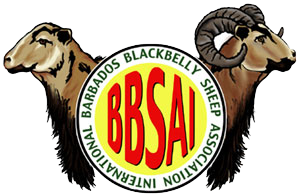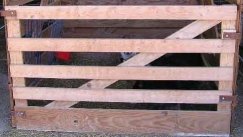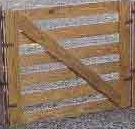By Mary Swindell
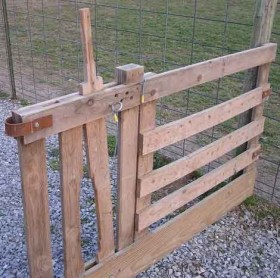
Introduction. Several sheep breeder friends have asked about the lambing jugs that they saw at my farm during the 2004 BBSAI Annual Meeting. These versatile 5-foot wide portable wooden panels can be put together in a variety of ways, including a basic 5-foot square lambing jug (pen), a set of such pens connected in a row, a portable zigzag fence, or a portable round corral.All of these configurations will stand alone, with no posts needed. I have two sets of these panels—the first set is 36 inches high, and the second set is 50 inches high.
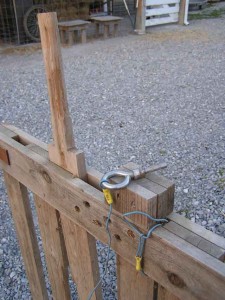
The first lamb pens I built were the set of short 36-inch high panels, made more or less according to the Midwest Plans for sheep housing and equipment. I made 7 of those panels (6 regular panels and one specialized panel, with a stanchion gate built into it). The stanchion gate is also known as a “head-catcher” gate, whereby you can hold a ewe inside the pen with her head and neck protruding through the adjustable vertical slats, and thereby force her to accept an orphan lamb in the pen.
Secondly, I built a set of six 50″ tall panels (also 5 feet wide). These were built after a particularly flighty Blackbelly ewe would continually jump out of the 36″ tall lamb pens, leaving her newborn lambs alone until I happened to come out to the barn to find her outside her pen. The taller panels worked very well to stop the mother ewe from escaping. These taller panels are also great to use for housing sick or injured sheep. The sheep are much calmer if they don’t think they could possibly jump out of the pen. They sense that there is no way they can clear this height from close quarters, so they relax and don’t worry themselves trying.
I have been using these two sets of panels as follows:
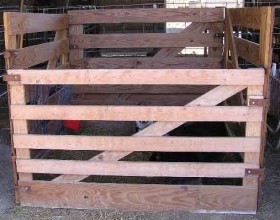
Lamb Pen Configuration. 3 sides of the pen are tall (50″ H) panels. The fourth side (front side) is a short (36″ H) panel. That way, I can reach in over the front to change water, feed grain & hay, and easily climb in to inspect mother and babies. The security of the 3 tall sides usually calms the ewe and they do not tend to jump over the shorter front panel, even though I guess they could. I have never had a ewe jump out of this configuration. Of course with a nervous or jumpy ewe, you could always switch to a higher front panel if needed.
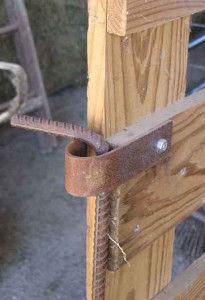
The panels can be set up side by side in a row, sharing side panels if you need to have more than one pen set up at the same time. The back pieces can be linked together with the hinge pen so that 3 panel pieces are joined in a “T” formation. That way, I can set up 3 total lambing pens side by side and utilize only 7 tall panels for the backs & sides of all 3 pens. Then I would simply need 3 short panels for the 3 front gates. These front panels, too, can be interjoined so that 3 pieces fit together. You can fit three panels together with a single hinge pin because of the way the hinge heights are staggered (low, medium, or high on the various panels). It is best to set up your lamb pen(s) in the warmest part of the barn, clearly out of a draft. And it is a good idea to put newborn lambs together with their mother in these pens for about 3 – 5 days.

Other Configurations. The panels can also be linked zigzag style in a single row to make an instant fence. If one or both ends are connected to a stable wall or fence, this portable fence will be freestanding.
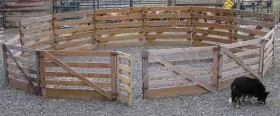
Additionally, they can also be connected in a big circle to make a portable holding corral. Again, this configuration will be freestanding if it is not too big. I have used all 13 panel pieces to make a corral circle and found it to be very stable. And I didn’t have to put any posts in the ground!
It is amazing how helpful these panels are for such uses. I have often pulled them out in a hurry to create a little alleyway when I needed to lead sheep to a new area (or to a loading ramp) where there was no fencing. When not in use, these panels can be stacked together out of the way. And possibly you readers will think of even more interesting configurations for these versatile panels on your own farms!
Construction Details. Here is the construction detail on both types of pen panels.
|
SHORT PEN PANELS — 36″ High x 60″ Wide |
TALL PEN PANELS — 50″ High x 60″ Wide. |
|
Spacing of horizontals:
(top) |
Spacing of horizontals:
(top) |
Assembly details (for both heights). Assemble with galvanized deck screws (1.5″ max.)
Hinges: 1/8″ thick strap metal, 1.5″ wide and 10″ long (for 36″ panel) or 11″ long (for 50″ panel). Bend into a U-shape 1 5/8″ wide. Drill hole through metal and wood to hold hex nuts & bolts (bolts 3/16″ diam. and 1 78″ long). 1 bolt per hinge. 4 hinges per panel (1 upper and 1 lower per edge). Important: Hinges must be positioned at carefully calculated low, medium, or high heights, so that each panel will coordinate with other panels and hinges can inter-fit with hinges of other panels.
Hinge positions for 50″ panels: High (bottom of top board). Medium (top of 2nd board). Low (Bottom of 2nd board). Bottom hinge can correspond as desired.
Hinge rods: 1/2″ rebar, 40″ long (for 36″ panel) or 54″ long (for 50″ panel). Bent at angle so 36″ (for 36″ panel) or 50″ (for 50″ panel) is vertical and there is a 4″ L-shaped handle at top. These are easily removable and can be slid down edge of panels to connect 2 or 3 hinged panels together.
